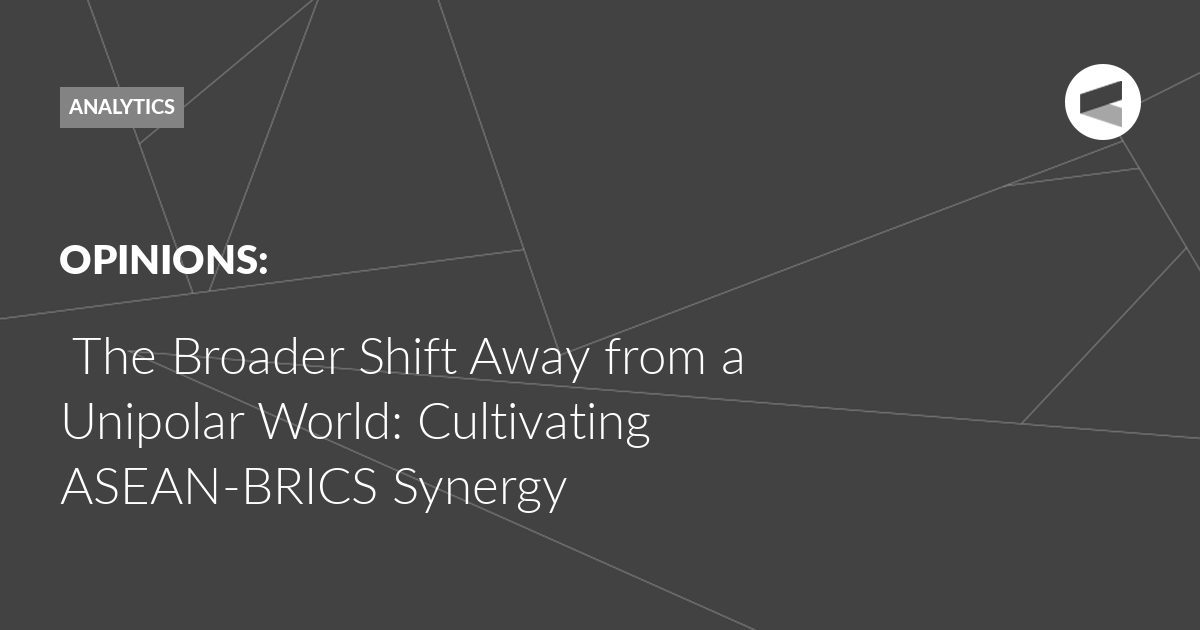The contemporary global framework is becoming increasingly fragmented and multipolar – with changes in our geopolitical and economic landscapes expected to further reshape strategies and potentially, alliances. Nevertheless, it still remains deeply interdependent, especially from a socioeconomic perspective. As global dynamics continue to evolve, it is crucial for stakeholders – whether regional blocs, sub-regional players, or transregional, mini-lateral entities to take on the role of facilitators – to mediate conflicts, foster multilateral cooperation, and counter agents of escalating global tension.
In this context, ASEAN is well-poised to take on a more pivotal role, a position it is relatively familiar with. Over the years, ASEAN has built a history of effectively engaging with a wide range of partners, acting as a stabilizing cog in the region and beyond. ASEAN centrality has been crucial here, allowing the bloc to maintain strategic autonomy and foster inclusivity, cementing its reputation as a reliable and pragmatic mediator. This is especially important in balancing the interests of both the West and the Global South. Traditional partnerships with Western stakeholders and dialogue partners such as Australia and Japan have and will always remain indispensable. However, in order to really play a leadership role in fostering synergies and advancing multilateral cooperation to address shared global challenges, ensuring a diverse range of trade and economic partnerships within and beyond the region is essential.
ASEAN member states and the bloc as a whole have been actively explored for avenues for diversifying trade options, establishing partnerships as well as strengthening external collaboration. Within this context, BRICS – a collective network representing nearly 30% of global GDP and 44% of the global population, has emerged as a significant actor. With ASEAN’s established reputation as a stabilizing regional bloc, the question arises: can BRICS and ASEAN synergise their interests in order to foster meaningful cooperation?
Shared Principles and Strategic Synergies
At the heart of the potential for greater ASEAN-BRICS synergy is the sharing of compatible principles such as respect for consensus-building, inclusive dialogue, and non-interference in internal affairs. These values have the potential to underpin ASEAN’s successful navigation of complex regional challenges and form a solid foundation for collaboration with BRICS.
As Dr. Pham Lan Dung, Acting President of the Diplomatic Academy of Vietnam has aptly observed, what sets both groups apart in the global context is their commitment to equality in decision-making. This implies that unlike some traditional institutions, BRICS operates without a dominant member or veto powers, ensuring that every member, regardless of relative size or economic weight, has equal voice in shaping the bloc’s direction. In other words, this reflects a democratic structure where no single power dominates, ensuring solidarity while fostering inclusivity. This approach resonates with ASEAN’s consensus-driven structure, which similarly emphasises equitable participation. INSAP concurs with this point of view as we believe such governance models could potentially serve as compelling alternatives, but not replacements to traditional frameworks that at times, marginalize smaller nations. They will also strengthen the appeal of both groups to other developing nations seeking platforms that respect autonomy while acquiring the opportunity to amplify voices at a global level.
This foundation of shared principles not only reinforces ASEAN-BRICS compatibility but also highlights the potential for their strategic synergies to unlock mutual opportunities. Moving beyond values and governance models, these synergies could translate into tangible socioeconomic benefits for both blocs. One key area for synergy is trade and investment. ASEAN’s dynamic economies and growing middle class present a lucrative market for BRICS nations, particularly in sectors such as energy, digital technology, and infrastructure. For instance, Russia, as a member of BRICS, can leverage its expertise in energy and natural resources to meet ASEAN’s growing demands. Conversely, ASEAN’s burgeoning manufacturing sector and technological innovation along with its growing middle class will not only provide BRICS with access to new supply chains and opportunities in areas like fintech and e-commerce, but also a huge consumer market to target.
In this context, INSAP believes that potentially further strengthening this emerging ASEAN-BRICS economic partnership is the shared recognition of the need to diversify approaches to financial systems – or, more simply to de-dollarise. This however does not imply throwing away the dollar but rather developing “supplementary payment systems.” This aligns with the perspective offered by Dr. Igor Makarov, Head of the School of World Economy and Head of the Laboratory for Climate Change Economics, HSE University – who argued during the 15th Asian Conference of the Valdai Club that “the goal is not to replace the US Dollar with any other currency, but to replace and substitute some of its functions and therefore build new elements of the global financial system.” This implies creating alternative mechanisms and reducing dependence on the dollar without entirely abandoning its use.
This shared desire for financial diversification, alongside cooperation in energy, technology, and infrastructure, ultimately strengthens the potential of an ASEAN-BRICS economic partnership, fostering a more resilient economic landscape – conducive to mutual growth and prosperity.
Challenges still remain
Geopolitical tensions frequently dominate the headlines, creating a complex and potentially challenging environment for deeper cooperation. However, INSAP also identifies the differing perspectives on global governance as a potential obstacle to mutual understanding and trust-building. Dr. Kuik Cheng-Chwee, Professor of International Relations at the Institute of Malaysian and International Studies (IKMAS), National University of Malaysia, aptly captured these complexities, suggesting during the conference that “The shifting global world order and regional tensions pose difficulties in aligning ASEAN principles of neutrality and inclusivity with certain BRICS members’ strategic imperatives.”
This underscores the delicate balance ASEAN members must strike between their existing relationships, which are often rooted in historical alliances and economic dependencies, and potential benefits of closer ties with BRICS nations. Beyond these geopolitical considerations, practical obstacles remain, such as cultural differences which can impede the development of strong people-to-people ties, which are crucial for fostering mutual understanding and trust. Logistical and regulatory hurdles, limited intra-bloc trade and the need for significantly greater private sector involvement and investment from BRICS nations present additional practical obstacles to overcome.
However, as Dr. Pamela Yong, chair of INSAP, optimistically highlighted at the end of the first day of the conference, “Aligning ASEAN with BRICS comes with challenges, due to the differing economic structures and geopolitical complexities. These differences, however, do not overshadow vast opportunities for cooperation.” This positive spirit underscores the significant potential for mutually beneficial partnerships despite the existing hurdles. By focusing on shared interests, open dialogue and flexible framework – ASEAN and BRICS can forge a stronger, more resilient and inclusive partnership that contributes to a prosperous future for not only both blocs but also the wider global community.
The Valdai Discussion Club was established in 2004. It is named after Lake Valdai, which is located close to Veliky Novgorod, where the Club’s first meeting took place.
Please visit the firm link to site






